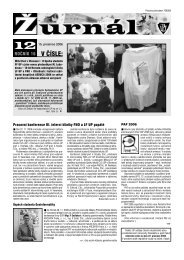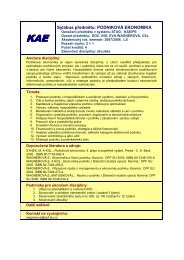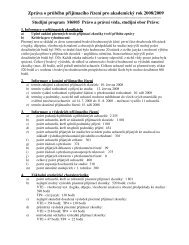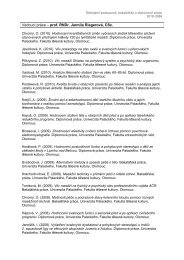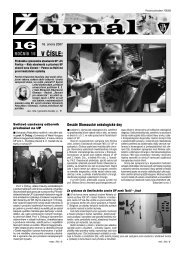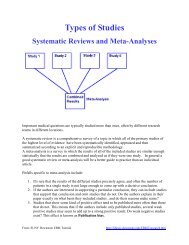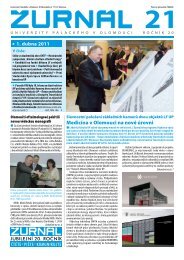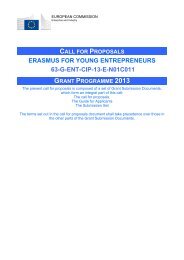ACTA UNIVERSITATIS PALACKIANAE OLOMUCENSIS GYMNICA ...
ACTA UNIVERSITATIS PALACKIANAE OLOMUCENSIS GYMNICA ...
ACTA UNIVERSITATIS PALACKIANAE OLOMUCENSIS GYMNICA ...
- No tags were found...
Create successful ePaper yourself
Turn your PDF publications into a flip-book with our unique Google optimized e-Paper software.
14 Acta Univ. Palacki. Olomuc., Gymn. 2004, vol. 34, no. 2maintained at a level that is somewhat lower than themean value for the investigated population (ClusterIII; N = 30) (Fig. 4). The next segment of the burnoutmacro-path in physical training teachers (the T2 phase)is unclear and requires further research. The final linkof the developing burnout process (the T3 phase) isCluster V (N = 69) (Fig. 3) that includes teachers characterizedby high values of all the three burnout dimensions.The epilogue of the macro-path determined in thetypological model is the one-element Cluster II (Fig. 2)that illustrates the extraordinary case of a male teacherwho experienced extreme burnout.Cluster IV (Fig. 5), treated in view of its low samplesize (N = 6) as a case study, was not included in themodel.DISCUSSIONThe population of physical education teachers employedin various schools (II–IV education level) depictsan interesting portrayal of the analyzed process. Witha relatively high number of burned-out teachers (N = 70;27.4%), a high percentage of the group is constituted byindividuals who have not experienced burnout (N = 150;58.6%). The results of studies carried out amonggeneral education teachers indicated a signifi cantlylower percentage of both non-burned out and burnedoutindividuals: Tucholska (2003) 20.7% and 32.8%(N = 256), Sekułowicz (2002) 6.6% and 13.8% (N = 99),Sęk (1996) 5.9% 1 and 14.3% (N = 119), respectively.Golińska & Świętochowski (1998) found no burnoutsymptoms in 15.4% of their sample (N = 395); at thesame time, more than 1/5 of the respondents indicateda considerable intensity and frequency of experiencingthe phenomenon. While performing self-evaluation,“(…) 19% of teachers assessed (…) their burnout levelas very high” (Przybyła, 1998, 18); 44% did not noticeany symptoms of the syndrome. Mandal (1999) signaledthe burnout syndrome symptoms as occurring in morethan one half of Polish teachers.The mean results of the analyzed group of physicaltraining teachers for particular dimensions – emotionalexhaustion (EE), negative sense of professionalachievements (NSPA) and depersonalization (DP) – aremarkedly lower as compared to the results obtained byTucholska (2003) 2 . Similar results were achieved instudies carried out in elementary (ES) and high school(HS) 3 teachers (Kliś & Kossewska, 1998). This suggeststhat the intensity of burnout is lower among physicaltraining teachers.The variable of gender basically does not play a differentiatingrole in the phenomenon of burnout amongphysical training teachers. The process of syndromeintensifi cation among females and males (the clusteranalysis) has a similar course (ANOVA, F = 0.881,p > 0.05); the analysis of burnout structure indicatesonly a slightly higher level of emotional exhaustionamong female physical training teachers (p < 0.05)(TABLE 1). A tendency towards more pronouncedpsychophysical and emotional exhaustion in femaleteachers was defined as a trend (p < 0.056) by Tucholska(2003).The above quoted results allow for cautious concludingthat physical training teachers as a professionalgroup do not experience negative effects of specifi cstress to the same degree as other teachers do. Whenyoung, the majority of physical training teachers wereinvolved in sports, although not necessarily at the highestlevel. Personality traits that differentiate betweensportspeople and non-sportspeople include extraversion,self-assurance, high motivation towards achievements,low anxiety level and a strong, healthy nervous system;all these factors in combination play a decisive role inresistance to stress (Czajkowski, 1996).A higher level of mental stamina is associated witha better ability to cope with stressful situations; highlyreactive individuals were found to be more susceptibleto burnout (Marek, 1993; Noworol & Marek, 1994, inDworzańska, 1999). Highly reactive teachers clearly deriveless satisfaction from working in schools (Golińska& Świętochowski, 1998). The sense of work-associatedsatisfaction among teachers is at the same time directlydependent on extraversion (Kliś & Kossewska, 1998).The more dynamic character of physical traininglessons and the possibility of conducting them in enclosed(a gym, body-building shop and others) and inopen spaces (a sports field, open terrain) exclude monotony.The ability of the teacher to join the students(participation in exercises or games, etc.) – in spite ofhis mentally and physically cumbersome work – allowshim to alleviate stress to a degree. Recreation at leisure,in touch with Nature, sports and mountain climbing(to which teachers of physical training seem to be predisposed)decrease the risk of burnout (Kwiatkowski,1993; Sęk, 1994).In comparison to general education teachers, theburnout phenomenon among teachers of physical trainingis relative more extensive – 27.4% of the investigatedgroup consisted of burned-out individuals. The syndromeoften affects highly motivated people, who have givenpriority to their career over other values (Paines, 1993;Schaufeli & Enzmann 1998, in Tucholska, 2003). Thehigh level of motivation and competitiveness, characteristicof sportspeople (Czajkowski, 1996) may accelerate1calculated based on data presented in TABLE 3.7, page 52 (Sęk, 1996)2EE = 12.7 and 21.07; NSPA = 11.0 and 14.52; DP = 4.10 and 6.41, respectively3ES and HS – EE = 13.9 and 20.9; NSPA = 31.5 and 27.6; DP = 5.7 and 8.0, respectively




